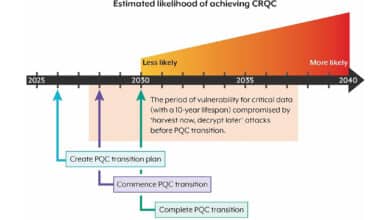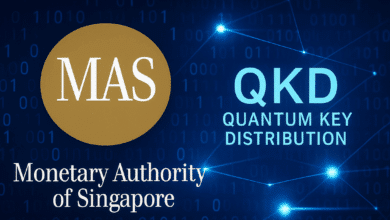FCA’s Latest Research Note Explores Quantum Computing in Financial Services

Table of Contents
03 Oct 2025 – The UK’s Financial Conduct Authority (FCA) has released a new Research Note titled “Quantum Computing Applications in Financial Services” authored by Charlie Markham (FCA) and Ross Grassie (formerly of the UK Quantum Software Lab).
FCA Research Notes are designed to stimulate debate and inform thinking across industry and policy without constituting formal FCA policy; they present rigorous analysis and the authors’ views rather than binding guidance. This latest note asks a simple but timely question: where might quantum computing matter first in finance, and what should firms and regulators do now to prepare?
Why Now?
The decision to focus on quantum in late 2025 is not incidental. The FCA frames this as a critical moment: commercial applications remain emergent, but technical progress is accelerating, and early, proportionate regulatory engagement can help the UK capture opportunities while managing risks for markets and consumers.
The macro‑context matters. Financial services account for roughly 9% of UK output and act as an enabler for innovation across the economy, while government has committed long‑horizon investment to quantum, notably the £2.5 billion National Quantum Strategy and further funding aligned to a growth agenda. The FCA signals it wants to be a “smarter regulator” so that regulation does not lag technology and inadvertently bottleneck innovation.
Opportunities for Quantum Computing in UK Financial Services
The note starts by demystifying the technology stack – from fragile physical qubits and error correction through compilers and orchestration to algorithms – and then pivots quickly to finance. Across interviews, workshops, and literature, three problem domains emerge as the most relevant near‑ to medium‑term:
- optimisation,
- machine learning, and
- stochastic modelling.
Each domain is examined on its own terms: where classical methods face headwinds; how quantum reframings might help; and what the current sentiment and barriers look like in practice.
Optimisation
Consider optimisation first, with portfolio construction as a concrete instance. Classical methods face exponential search spaces and intricate constraints; to keep runtimes practical, practitioners accept heuristics and “good enough” solutions, particularly as asset universes and constraints grow. The quantum reframing begins by casting the core combinatorial selection problem as a quadratic unconstrained binary optimisation (QUBO): assets become binary variables, diversification and co‑movements are encoded in the cost function, and the search is guided by quantum circuits that exploit superposition and entanglement to explore many configurations in parallel. Algorithms like the Quantum Approximate Optimisation Algorithm (QAOA) iteratively amplify promising configurations – those closer to a better risk‑return trade‑off – so that, upon measurement, high‑quality portfolios are more likely to be sampled. Yet the note is careful: today’s quantum devices and solvers do not outperform state‑of‑the‑art classical optimisers on realistic instances; the industry’s stance is cautious optimism, with a medium‑ to long‑term horizon for meaningful deployment. Key frictions are not only hardware scale and error rates, but also hybrid integration – moving data and control efficiently between classical and quantum components without losing any theoretical speed‑up to orchestration overhead.
Machine Learning
Machine learning is the second domain, and the FCA wisely structures the discussion around a standard supervised workflow: data collection, pre‑processing, training, testing, and evaluation. Finance presents difficult data regimes – noisy, sparse, and highly imbalanced (think rare but costly events such as fraud) – and complex, high‑dimensional feature spaces with non‑linear dependencies that make large classical models expensive to train and brittle to regime change. Quantum approaches are being explored at two touchpoints. First, quantum‑enhanced feature engineering uses quantum feature maps to embed classical data into rich Hilbert spaces that may make classes more separable, with the practical aim of improving accuracy or reducing retraining burden in hybrid pipelines. Second, quantum models such as quantum support vector machines that implement kernel methods natively on quantum states, promise expressivity with compact resources, at least in theory. Fraud detection is an illustrative testbed: a binary classification problem with severe class imbalance, constantly shifting typologies, and stringent latency requirements in production. Here, firms are experimenting with quantum‑assisted pre‑processing to accelerate retraining and with small‑scale quantum models, while acknowledging practical constraints: data‑loading bottlenecks, slow quantum–classical interconnects, and the reality that transaction‑level inference often demands millisecond‑scale responses that current quantum access cannot match. The upshot is exploratory: hybrid quantum–classical ML is a sensible near‑term focus, but definitive quantum advantage in live financial ML remains over the horizon.
Stochastic Modelling
The third domain, stochastic modelling, is arguably the most mathematically crisp in its quantum promise. Monte Carlo methods underpin pricing of complex derivatives, risk measures such as VaR/CVaR, and stress testing by simulating many paths to approximate distributions of outcomes; accuracy improves only with the square root of the number of samples, making classical Monte Carlo computationally expensive at high precision. Quantum Amplitude Estimation (QAE) changes that rate: in ideal settings it yields a quadratic speed‑up in convergence, halving error with roughly twice (instead of four times) the samples. The note explains how superposition allows many paths to be encoded simultaneously, how an ancilla qubit’s amplitude can be made to carry the expected value, and how Quantum Phase Estimation extracts that value without reverting to inefficient repeated sampling. But it also stresses the implementation gap: the circuits are deep, error correction overheads are heavy, and constant factors may erode the practical advantage; in short, “quadratic” does not automatically mean “commercially compelling” on today’s or near‑term hardware. Still, because the theoretical case is clean and the business linkage direct (pricing and risk), firms continue to regard quantum Monte Carlo as a leading candidate for early practical impact once the full stack matures.
Regulatory Considerations and the FCA’s Approach
After mapping the technical landscape, the note turns to regulation with a technology‑neutral, outcomes‑focused lens. Rather than drafting new rules, the FCA convened internal workshops built around future scenarios abstracted from the use cases, explicitly avoiding quantum jargon to reduce novelty bias and focus on market outcomes and existing obligations. Several cross‑cutting considerations emerged.
Explainability remains foundational: under regimes such as the Consumer Duty, firms must both make sound decisions and demonstrate how those decisions were reached; quantum models risk compounding the AI “black box” challenge unless firms record inputs, transformations, and controls in ways that can be interrogated by supervisors and explained to customers.
Validation and benchmarking remain non‑negotiable; reproducibility may be complicated by probabilistic outputs and hardware variability, but firms should be able to demonstrate equivalence, e.g., distributional alignment for quantum Monte Carlo estimates or stability bands for quantum optimisers, against accepted benchmarks.
Operational resilience and concentration risk are also salient. If a small number of quantum service providers become critical, the pattern will rhyme with cloud: firms must plan for outages and degraded performance and maintain viable fallback (including reversion to classical systems), even though “switchback” may be non‑trivial and outputs may not be identical across providers.
Market integrity and competition will need active surveillance as quantum enters market‑facing processes; the concern is not the technology per se but the effects – short‑lived but material advantages that could, in aggregate, stress fairness or orderly trading if left unchecked. And data governance issues – moving sensitive data into novel environments run by small specialists – should be managed with existing security and data‑sharing codes rather than treated as uniquely quantum problems.
Finally, coordination matters: internationally through IOSCO/FSB and domestically across the FCA, Bank of England, and PRA, to avoid fragmentation or regulatory arbitrage as applications mature.
Perhaps the most forward‑leaning regulatory idea in the note is an Applications Regulatory Readiness Framework. Building on the UK’s “regulation by application” approach recommended by the Regulatory Horizons Council, the FCA sketches a way to assess the maturity of specific quantum applications and match them to proportionate tools – dialogue and observation for nascent ideas, sandboxes and structured pilots for maturing ones, and more formal supervisory expectations as deployments approach production. The point is not to regulate quantum as a technology, but to keep pace with its uses, acting early where needed and standing back where appropriate.
Implications for Quantum Readiness Across the Financial Ecosystem
What should the ecosystem do with this? For financial institutions, the signal is to build quantum readiness deliberately. That does not mean large budgets or immediate bets; it means no‑ or low‑regret moves such as skills development, internal governance for experimentation, and targeted proofs‑of‑concept with academic and vendor partners, that create real options for the future and prevent capability atrophy if the technology surprises to the upside. Some firms will sensibly adopt a second‑mover posture; others will push deeper and earlier into algorithmic research or hybrid integration. The FCA’s message accommodates both, but warns against being caught flat‑footed.
For quantum vendors, the advice is equally clear: treat regulatory engagement as a first‑class product capability. Many vendors are understandably focused on science and engineering, but low awareness of regulatory frameworks can create perceived barriers that slow adoption. Early relationships with supervisors – sharing pilots, clarifying controls, and aligning validation practices – lower uncertainty for banks and become a commercial enabler in their own right. As applications mature, demonstrable regulatory alignment (operational resilience, explainability, benchmarking) will be a differentiator, not an afterthought.
And for regulators themselves, the work continues: invest in internal expertise, keep channels open with industry and academia, and adapt proven innovation tools – sandboxes, observation of PoCs, dedicated specialist teams – to the quantum context. The aim is to support safe experimentation while preserving market integrity and consumer protection, signalling that the UK is ready to translate scientific lead into real‑world impact.
The animating idea of the FCA’s Research Note is measured pragmatism. Quantum is moving from theory toward practice in finance; advantages are plausible in optimisation and ML (especially as hybrids), and provable—though not yet practical at scale—in Monte Carlo. The question is less if than when and where first, and how to be ready.
Quantum Upside & Quantum Risk - Handled
My company - Applied Quantum - helps governments, enterprises, and investors prepare for both the upside and the risk of quantum technologies. We deliver concise board and investor briefings; demystify quantum computing, sensing, and communications; craft national and corporate strategies to capture advantage; and turn plans into delivery. We help you mitigate the cquantum risk by executing crypto‑inventory, crypto‑agility implementation, PQC migration, and broader defenses against the quantum threat. We run vendor due diligence, proof‑of‑value pilots, standards and policy alignment, workforce training, and procurement support, then oversee implementation across your organization. Contact me if you want help.



